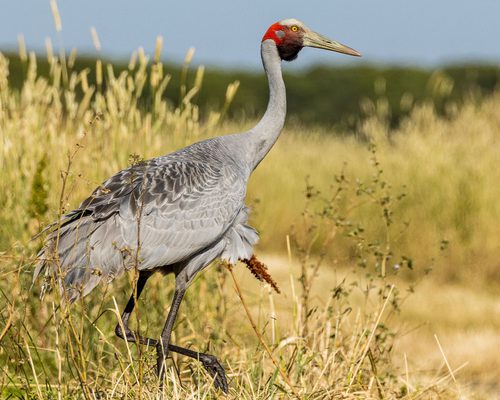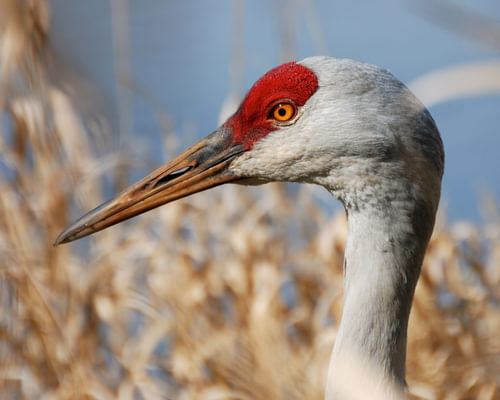Sarus Crane
VulnerableGrus antigone
Visual Identification
Appearance
The Sarus Crane is the tallest flying bird, with a striking grey body, long pink legs, and a bare red head and upper neck. Its wings have black flight feathers, contrasting with the lighter grey body plumage.
Both sexes look similar, with males being slightly larger. Juveniles have a brownish-grey head and neck, gradually acquiring adult colouration over their first year.
Size
Length
152cm to 156cm
Wingspan
220cm to 250cm
Weight
5kg to 8kg
Colours
Males and females have similar plumage
Primary Colour
Grey
Secondary Colour
Red White
Beak Colour
Grey
Leg Colour
Pink
Habitat and Distribution
Habitats
Woodland
Garden
Wetland
Coastal
Urban
Farmland
Grassland
Desert
Tundra
Rainforest
Mountain
Savanna
Distribution
Sarus Cranes inhabit wetlands, marshes, and agricultural landscapes across parts of the Indian subcontinent, Southeast Asia, and northern Australia. They are closely associated with areas of shallow water and open grasslands.
In Australia, they are found in the northern regions, particularly in Queensland. The cranes are non-migratory, maintaining year-round territories in suitable habitats.
Elevation Range
Up to 1,500 meters
Climate zones
Tropical, Subtropical
Distribution Map
This map gives you a rough idea of where you might spot a Sarus Crane. The coloured areas show countries where these birds have been seen.
A few things to keep in mind:
- Birds might not be everywhere in the coloured areas, for example, they may be present around the coast of that country
- Where birds live can change with seasons and available food
- This map is quite simple - it doesn't show exact locations
We're working on making our maps even better! Soon, we hope to show you:
- More detailed maps for bigger countries, including state and region
- How birds move around during different seasons
Behaviour and Ecology
Bird Attributes
This feature is in beta. We'd love your feedback to improve it!
Share your thoughtsBird Attributes Explained
Our bird attributes system rates various aspects of a bird's capabilities on a scale of 0-100, based on data from field observations, scientific studies, and expert knowledge.
Attribute Categories:
- Agility: Manoeuvrability, speed, and grace in flight or movement.
- Strength: Physical power, often correlating with size and hunting abilities.
- Adaptability: Ability to thrive in various environments or changing conditions.
- Aggressiveness: Territorial behaviour and assertiveness, particularly during breeding seasons.
- Endurance: Stamina, often seen in migration patterns or foraging behaviours.
Understanding the Ratings:
- 0-20: Very Low
- 21-40: Low
- 41-60: Average
- 61-80: High
- 81-100: Very High
Remember, these attributes are relative to other bird species and don't necessarily indicate superiority.
Hover over the icon next to each attribute for more information.
Tap the icon next to each attribute for more information.
Agility
Reflects the bird's manoeuvrability, speed, and grace in flight or movement.
The Sarus Crane demonstrates considerable agility for its size, particularly during its elaborate courtship dances which involve synchronized jumping and wing flapping. Its ability to navigate wetlands and agricultural fields also suggests good manoeuvrability.
Strength
Indicates the bird's physical power, often correlating with size and hunting abilities.
As the tallest flying bird in the world, the Sarus Crane possesses remarkable strength. Its ability to take flight despite its large size (up to 8 kg) and defend territories fiercely indicates substantial physical power.
Adaptability
Represents the bird's ability to thrive in various environments or changing conditions.
Sarus Cranes show adaptability in their diet and habitat choices, thriving in wetlands, marshes, and agricultural landscapes. However, their vulnerability to habitat loss and dependence on specific breeding conditions slightly limit this score.
Aggressiveness
Measures the bird's territorial behaviour and assertiveness, particularly during breeding seasons.
During breeding season, Sarus Cranes are highly territorial and fiercely defend their nesting areas. Their large size and powerful bills make them formidable opponents, contributing to their aggressive nature when protecting their territory or young.
Endurance
Reflects the bird's stamina, often seen in migration patterns or foraging behaviours.
The Sarus Crane's ability to maintain year-round territories, engage in long courtship displays, and care for young for extended periods (up to 10 months) suggests high endurance. Their potential longevity (over 40 years in captivity) also indicates robust stamina.
Diet
Sarus Cranes are omnivorous, feeding on a variety of plant matter, insects, small vertebrates, and aquatic organisms.
They often forage in shallow water or agricultural fields, using their long bills to dig for tubers and probe for invertebrates in mud or soft soil.
Behaviour
Sarus Cranes are known for their elaborate courtship dances involving synchronised jumping, wing flapping, and bugling calls. They are highly territorial during the breeding season, fiercely defending their nesting areas.
These cranes often forage in shallow water, using their long bills to probe for food.
Vocalisation
Sarus Cranes are known for their loud, trumpeting calls, often given in unison by pairs. Their distinctive 'kar-kar-kar' call can be heard over long distances, especially early morning and evening. During courtship, pairs perform synchronised calling, creating a haunting duet.
Nesting & Breeding
Sarus Cranes form monogamous pairs that often mate for life. The breeding season varies by region but typically coincides with the monsoon or wet season. Pairs engage in elaborate courtship displays to strengthen their bond.
Nests are large platforms of vegetation, usually built in shallow water or on the ground in wetlands. The female typically lays two eggs, which are pale bluish-white with brown spots.
Both parents incubate the eggs for about 31-34 days. Chicks fledge at 85-100 days but stay with their parents for up to 10 months, learning essential survival skills.
Lifespan
The Sarus Crane typically lives for 30 to 40 years, with a maximum recorded lifespan of 41.8 years.
Like all birds, lifespan can be affected by factors including predation, habitat quality, disease, and access to food sources.
Conservation and Status
Global Conservation Status
The Sarus Crane faces threats from habitat loss, agricultural intensification, and wetland drainage.
Conservation efforts focus on protecting wetland habitats, reducing pesticide use in agricultural areas, and community-based conservation programs to safeguard nesting sites.
Birdwatching Tips
- Look for Sarus Cranes in wetlands, paddy fields, and agricultural areas
- Listen for their loud, trumpeting calls, especially at dawn and dusk
- Observe from a distance to avoid disturbing nesting pairs
- Use a spotting scope for detailed views of their distinctive red head and neck
Additional Information
Quick Facts
Other names:
Indian Sarus Crane, Antigone antigone
Family:
GruidaePredators
Adult Sarus Cranes have few natural predators due to their size, but eggs and chicks are vulnerable to jackals, feral dogs, and large raptors.
Did You Know?
- Sarus Cranes are the tallest flying birds in the world.
- They can live for up to over 40 years in captivity.
- In some cultures, Sarus Cranes are considered symbols of marital fidelity.
Was this bird profile helpful?
Your feedback helps us improve our content
Thanks for your feedback!
Your input helps us improve our content.
Community Experience
Community Ratings
No ratings yet - be the first to rate this bird!
Latest Community Reviews
No reviews yet
Sign in to be the first to review
Community Reviews
Create Your Free Account Welcome Back!
Join our community to rate birds and share your experiences. Creating an account is completely free and only takes a minute. Sign in to your account to rate birds and share your experiences with our community.
Your information is secure and will never be shared.
By creating an account, you agree to our Privacy Policy.
Similar Birds
References
- 2 4
website: BirdLife International. 2016. Antigone antigone. The IUCN Red List of Threatened Species 2016: e.T22692064A93335364.
View source - 1 3
report, 2006: Wetlands International

